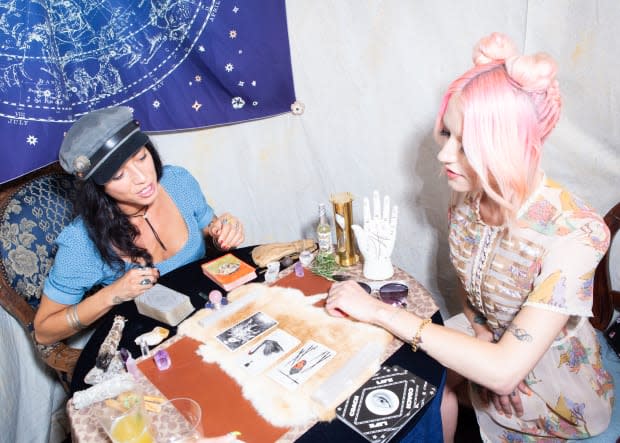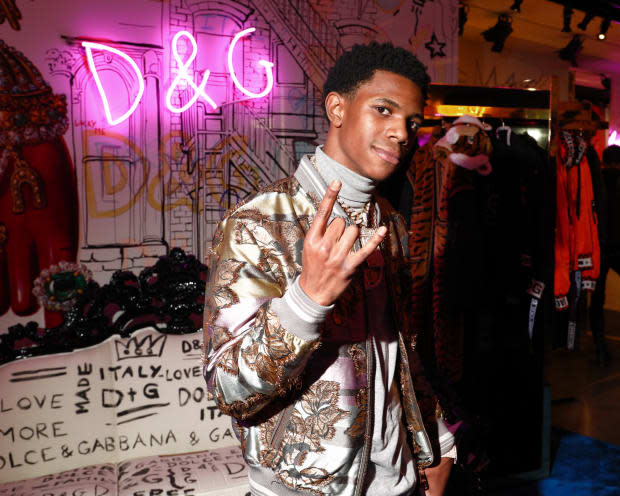The Hot New Trend in Luxury Retail? Not Selling Anything
Brands like Hermès, Dolce & Gabbana and Coach have created separate spaces just to hang out with (and maybe Instagram-bait) you.

As retailers are finding it increasingly difficult to get shoppers (particularly new, young ones) into their brick-and-mortar stores, a slew of luxury brands seem to have a strategy for engaging consumers: Get them to go somewhere else — not to shop, but to hang out.
This summer, Dolce & Gabbana opened a "cultural hub," as it's calling it, on Mercer St. in Soho, New York. While one can shop there during the day, the space is first and foremost a luxurious, Instagrammable clubhouse for the youths. It hosts monthly events, like a concert featuring up-and-coming bands, or a "drink and draw" night.
Also this summer, Coach debuted Life Coach, an experiential pop-up in New York meant to "lead guests on a journey of self-discovery." It contained exactly zero products for sale; instead, it housed immersive and photogenic rooms. Perhaps you saw one made to look like a New York City subway station, where guests could graffiti the walls, on your social media feeds; there was also a Coney Island-inspired room with games and a mystical forest with tarot card readings.
Over the past few months, Hermès, the most exclusive and luxurious of all exclusive, luxurious brands, opened "Carré Club" (carré means "scarf") pop-ups in New York, Toronto, Singapore, Los Angeles and Milan. With free public admission, guests could get photos taken, sing karaoke (sorry, Carré-Ok), enjoy complimentary refreshments from a café and watch artists and designers work in an on-set atelier. Scarves were available to purchase, but they were in no way the main focus of the event.

In September in London, Matchesfashion.com opened 5 Carlos Place, a Mayfair townhouse with a retail component that most notably serves as a community space where all sorts of event programming has and will take place, as well as live streaming and podcasts for those who can't visit it in person — think high-level events like book signings, panel discussions, supper clubs, luxury brand installations and intimate musical performances. The opening follows a series of temporary residencies the retailer held in cities like New York, Los Angeles, Paris and Hong Kong for its 30th anniversary featuring similar types of engaging, often-educational events.
Chances are, you've seen at least one of these activations on Instagram, but aside from their photogenic designs, they all have one major (and initially surprising) thing in common: Unlike the many ephemeral retail concepts that came before them, the main goal here is not to sell you stuff. These brands are investing in physical spaces and events without any expectation that they will see a return on that investment — at least not a return that can be measured in dollars.
This concept didn't exactly come out of nowhere. There was February’s Chanel Beauty House in LA featuring room after room of Instagrammable moments. Tiffany & Co. opened its Blue Box Cafe last fall, resulting in a robin's-egg-blue flood of "breakfast at Tiffany" Instagram posts, and it's still tough to get a reservation there. Nordstrom debuted its Local concept in 2018, where service is prioritized over inventory. All the way back in 2016, Burberry opened Makers House in London, a pop-up featuring activities and installations meant to showcase the work of British artisans, which it revived in 2017.

Brands and retailers have also started to create Instagrammable moments and/or host workouts, Q&As and panel discussions in their existing stores with increasing frequency, some going so far as to host their own festivals and conferences (see: the In Goop Health wellness summit, Beautycon and Sephoria). Outside of the luxury fashion and beauty markets, Instagram-fueled experiential spaces have reached a fever pitch in cities like New York and LA, from Refinery29's 29Rooms to the Museum of Ice Cream to the Rosé Mansion that draw lines of people simply hoping to get some good content out of their outing.
"Lululemon really started this shift a number of years ago when it started offering yoga classes in-store," explains Petah Marian, senior editor for WGSN Insight. "It's evolved as other brands saw how consumers bought into this strategy, and then evolved it for their brands."
Today, we're seeing more instances of brands creating these experiences outside of their stores, simply because people don't need to go to stores anymore. "There is a shift taking place where people aren't as keen to spend Saturday afternoons wandering around the mall looking at stuff, because they're largely doing that on their phones," says Marian. "Experiences give them a reason to come into a retailer's space and have an interaction with a brand."
For luxury labels, which tend to be especially precious about their messaging and often shy away from inclusivity and accessibility for fear of brand dilution, the goal should be to convey the value of their brand and product to people who aren't going to visit their store to find that out. "Consumers are increasingly discerning, and simply placing an expensive item on a rail is not going to convince the customer of its worth," says Marian. "These events help create the perception of a product or retailer as a purveyor of valuable goods." Take the Hermès Carré Club, which was clearly about educating attendees about the brand's heritage in an accessible, entertaining way.
Coach's Chief Marketing Officer Carlos Becil tells Fashionista how the company chose to promote its signature collection from Spring 2018: "Instead of being more precious with it, we really set out a plan to be much more inclusive." Hosting the pop-up in a separate space from its retail stores and having nothing to sell were both conscious decisions. "We deliberately wanted to create a new environment and not have the limitations of a pre-designed retail space," he says. That way, guests could "roam throughout the spaces and be on a discovery mission and explore." The goal? That "every single person that walked through it had a very unique experience and walked out of there with a sense of what Coach was about."
Matchesfashion Chief Brand Officer Jess Christie explains that it now takes more than offering free champagne in a store to create a community-like experience. After the 30th anniversary residency events, she realized, "People were looking to make more connections, and the storytelling and content aspects were more important." With the residencies and 5 Carlos Place, the goal is to create community and inspire loyalty, acquiring new customers while engaging existing ones with sophisticated events and educational talks. Marian thinks this is the right way to go about things. "The events they host fit in with ideas of modern luxury around intellectual sophistication," he says. The retailer's sales rose 44 percent last year, so whatever it's doing seems to be working.
Another goal of these experiences is, of course, to generate social media content that those who aren't in attendance will see. "A lot of times, you're like, does it make a good picture for Instagram? That wasn't our first thought," Becil claims. "Our first thought was: How does this space make you feel? If it makes you feel a certain way, you're going to want to capture it; you're going to want to share it."
A rep for Dolce & Gabbana who preferred not to be quoted was open about the fact that the Italian house's space was largely meant to generate social media content. As with its entire marketing strategy lately, from runway shows to campaigns, it's designed to engage younger shoppers, namely millennials, who might not otherwise feel inclined to walk into a regular Dolce & Gabbana store.
"It surprised us when we did In Residence in the U.S., the reach we got was just incredible," says Christie. "In New York and LA, a few thousand customers [in attendence] across all events reached over 21 million on social and Facebook Live."
For most of these events, the metric of success is engagement. Becil says that visitors spent an average of an hour inside the Life Coach space and that social media engagement and editorial coverage exceeded the brand's expectations. He confirmed Coach plans to debut different versions of Life Coach in China, Japan and across North America over the next year, starting with Shanghai, where it's staging its Pre-Fall show on Dec. 8, suggesting the first pop-up was a success.

Many of these experiential concepts are meant to engage young people and generate social media content, but, increasingly, that's not enough. "We are going to get to a point where consumers tire of 'brand museums,' those that are just backdrops for Instagram shots," says Marian. "They will start to seek more from those experiences — to learn, play, connect (with a brand or likeminded individuals) or feel a sense of wonder."
Indeed, the brands mentioned in this story seem to be getting that. Matchesfashion's programming has expanded beyond fashion to encompass a 360-degree lifestyle, including workouts and panels on wellness, spirituality and how to become an art collector. Culturally, Christie feels luxury shoppers have "moved away from being on the surface and about status; it's about all what makes you an interesting person, and that's the music you listen to, your food, wellness ... it feels very considered."
On Thursday, Anya Hindmarch will begin a four-day series of events at her Sloane Street store in London geared towards helping attendees get more organized, literally. There will be talks led by productivity enhancement experts who train Google employees, as well as Gill Hasson, the author of "Declutter Your Life," and Helena Morrissey, a financier and mother-of-nine, according to WWD.
That's exactly the sort of thing Marian thinks we'll start seeing brands do next: "Experiences that add more value to a consumers' life, stuff around co-creation, learning new skills, and helping people to live their best lives."
It makes sense given that millennials are increasingly prioritizing self-care and self-improvement when it comes to how they spend their money. It's probably why the name Life Coach resonated so well: In the U.S., the self-improvement market is expected to grow 5.6 percent per year, reaching $13.6 billion by 2022. Millennials reportedly spend twice as much as baby boomers on things like exercise, diet plans, therapy and, yes, actual life coaching.
Brands are just starting to reach millennials where their money is, and while these inventory-less experiences might not drive sales immediately, they will put those brands at top of mind for said millennials when they are ready to make a big purchase, which is increasingly important and invaluable in today's crowded landscape.
Never miss the latest fashion industry news. Sign up for the Fashionista daily newsletter.
